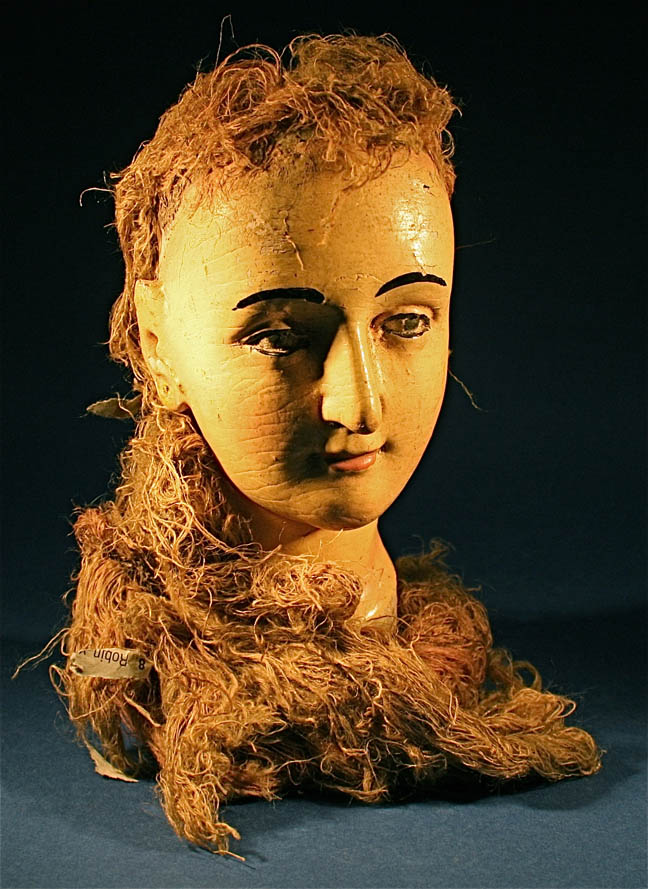

Title: Antique Wooden Madonna Sculpture Carved Virgin Mary Head
Shipping: $29.00
Artist: N/A
Period: Unassigned
History: N/A
Origin: N/A
Condition: Museum Quality
Item Date: 1890 to 1940
Item ID: 4634
Hand carved head of the Virgin Mary, This is a antique wooden carved polychrome figure of the Virgin Mary. Hand painted in polychrome over thin gesso. Obvious losses throughout; worming; some repair. There is still a lot of great decoration to the art work. In some European countries, such as Germany, Italy and Poland sculptures of the Madonna are found on the outside of city houses and buildings, or along the roads in small enclosures. A roadside Madonna in Ocieka, Poland. In Germany such a statue placed on the outside of a building is called a Hausmadonna. Some date back to the Middle Ages. In Italy the roadside Madonna is a common sight both on the side of buildings and along roads in small enclosures. These are expected to bring spiritual relief to people who pass them. Some Madonnas statues are placed around Italian towns and villages as a matter of protection, or as a commemoration of a reported miracle.
Link: http://en.wikipedia.org/wiki/Virgin_Mary
Mary (September 8, 20 BC?-January 1, 45 AD?) Aramaic, Hebrew: MaryÄm Miriam; Arabic: Maryam), usually referred to by Christians as the Virgin Mary or Saint Mary and occasionally Madonna, was a Jewish woman of Nazareth in Galilee, identified in the as the mother of Jesus Christ. Muslims also refer to her as the Virgin Mary or Syeda Mariam, which means Lady Mary. The New Testament describes her as a virgin (Greek parthÃnos). Christians believe that she conceived her son miraculously by the agency of the Holy Spirit. This took place when she was already the betrothed wife of Saint Joseph and was awaiting the concluding rite of Jewish marriage, the formal home-taking ceremony. Roman Catholics believe that Mary was conceived and born without the stain of Original Sin, thereby making her sinless, perfect, and immaculate from all forms of evil. In Islam she is regarded as the virgin mother of the prophet Jesus. She is described in the Qur'an, in the Sura Maryam (Arabic: The New Testament begins its account of Mary's life with the Annunciation, the appearance to her of the angel Gabriel heralding her divine selection to be mother of Jesus. However, early non-biblical writings state that she was the daughter of Joachim and Saint Anne. The Bible records Mary's role in key events of the life of Jesus from his virgin birth to his crucifixion. Other apocryphal writings tell of her subsequent death and bodily assumption into heaven. A number of important doctrines concerning Mary are held by Christian churches. Primary among these is that, as mother of Jesus, she became Theotokos, literally, the "God-bearer", or "Mother of God". This doctrine was confirmed by the First Council of Ephesus in 431. Christians of the major ancient traditions including the Catholic Church and the Eastern Orthodox Church believe that Mary lived a sinless life, offer prayers to God through Mary and venerate her as intercessor and mother of the church. Most Protestants, however, do not follow these devotions. The Apostles' Creed and Nicene Creed both refer to Mary as "the Virgin Mary". This alludes to the belief that Mary conceived Jesus through the action of God the Holy Spirit, and not through intercourse with Joseph or anyone else. That she was a virgin at this time is affirmed by Eastern Christianity, Roman Catholicism and many Protestants. Rejection of this is considered heretical by many, but not all, traditional Christian groups. The Gospel of Matthew describes Mary as a virgin who fulfilled the prophecy of Isaiah 7:14. The Hebrew word almah that appears in this verse, and the Greek word parthenos that Jews used to translate it in the Greek Septuagint that Matthew quotes here, have been the subjects of dispute for almost two millennia, since almah simply means young woman, rather than virgin (in Hebrew, the word betulah would be an unambiguous translation). This disagreement is related to the question of whether Isaiah 7:14 is a prophecy of Jesus' birth. Regardless of the meaning of this verse, it is clear that the authors of the Gospels of Matthew and Luke consider Jesus' conception not the result of intercourse and assert that Mary had "no relations with man" before Jesus' birth.